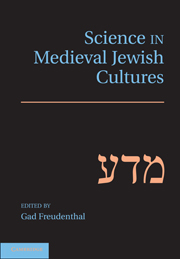Book contents
- Frontmatter
- Contents
- Contributors
- Preface and Acknowledgments
- Introduction: The History of Science in Medieval Jewish Cultures
- Part I The Greek-Arabic Scientific Tradition and Its Appropriation, Adaptation, and Development in Medieval Jewish Cultures, East and West
- Part II Individual Sciences as Studied and Practiced by Medieval Jews
- Part III Scientific Knowledge in Context
- 20 Medieval Karaism and Science
- 21 Science in the Jewish Communities of the Byzantine Cultural Orbit
- 22 Philosophy and Science in Medieval Jewish Commentaries on the Bible
- 23 Kabbalah and Science in the Middle Ages
- 24 History, Language, and the Sciences in Medieval Spain
- Name Index*
- Subject Index*
- References
21 - Science in the Jewish Communities of the Byzantine Cultural Orbit
New Perspectives
from Part III - Scientific Knowledge in Context
Published online by Cambridge University Press: 05 June 2012
- Frontmatter
- Contents
- Contributors
- Preface and Acknowledgments
- Introduction: The History of Science in Medieval Jewish Cultures
- Part I The Greek-Arabic Scientific Tradition and Its Appropriation, Adaptation, and Development in Medieval Jewish Cultures, East and West
- Part II Individual Sciences as Studied and Practiced by Medieval Jews
- Part III Scientific Knowledge in Context
- 20 Medieval Karaism and Science
- 21 Science in the Jewish Communities of the Byzantine Cultural Orbit
- 22 Philosophy and Science in Medieval Jewish Commentaries on the Bible
- 23 Kabbalah and Science in the Middle Ages
- 24 History, Language, and the Sciences in Medieval Spain
- Name Index*
- Subject Index*
- References
Summary
Enormous problems of a very basic sort confront the historian who would write a chapter on science in the Byzantine Jewish communities. What temporal and geographical bounds define Byzantium? Even the most preliminary investigation – and the present study claims to be no more than a very initial probing – reveals that the conventional boundaries employed in political history, for example, are not applicable. The Near East, from Syria to Egypt, was Byzantine until the Muslim conquests of the eighth century. Some seminal texts of medieval Hebrew science were (with varying degrees of probability) produced in those regions while they were under Byzantine rule, and the Greek language was widely known, even if it was not the everyday speech of Jews: These texts include Pirqei de-Rabbi Eliezer, Baraitha di-Mazzalot, Sefer ʾAsaf, and perhaps even Sefer Yeṣirah. Yet none of these texts can be considered to belong to the corpus of writings that compose, if I may call it such, “classical” Byzantine-Jewish science – by which I mean the activity of Mordechai Komatiano and other persons who flourished in the fourteenth and fifteenth centuries. Those figures are every bit as remote from those early texts as were their contemporary co-religionists in the Iberian peninsula or southern France. On the other hand, there seems to be no good reason to stop talking about Byzantine science after 1453. The work of people such as R. Elijah Mizraḥi, even if carried out after Constantinople had been under Ottoman rule for some time, appears to all intents and purposes to be a continuation of the Byzantine tradition.
- Type
- Chapter
- Information
- Science in Medieval Jewish Cultures , pp. 438 - 453Publisher: Cambridge University PressPrint publication year: 2012
References
- 2
- Cited by



